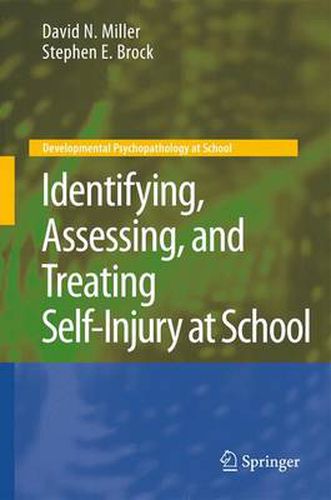Readings Newsletter
Become a Readings Member to make your shopping experience even easier.
Sign in or sign up for free!
You’re not far away from qualifying for FREE standard shipping within Australia
You’ve qualified for FREE standard shipping within Australia
The cart is loading…






This title is printed to order. This book may have been self-published. If so, we cannot guarantee the quality of the content. In the main most books will have gone through the editing process however some may not. We therefore suggest that you be aware of this before ordering this book. If in doubt check either the author or publisher’s details as we are unable to accept any returns unless they are faulty. Please contact us if you have any questions.
Nonsuicidal self-injury (NSSI) among young people-most notably in the form of forearm- or wrist-cutting-occurs across cultural groups, social strata, and developmental stages, puzzling and repelling adults. Youth engaging in NSSI behaviors are at a higher risk for suicidality as well as other mental health and academic problems. And because NSSI is often first noticed in the school setting (as is the case with many children’s disorders), school professionals are being encouraged to take a more proactive role in intervention.
The first book specifically geared toward education personnel, Identifying, Assessing, and Treating Self-Injury at School clearly defines NSSI, differentiating it from suicidal, borderline, and other behaviors and analyzing the psychological contexts in which it occurs. This school-based perspective gives readers a practical framework for earlier, more accurate diagnosis; relevant consulting with parents, teachers, and colleagues; and effective, science-based treatment.
Included in the coverage: an overview of causes of self-injury, current findings on prevalence and associated conditions, early screening guidelines, including risk factors and warning signs, the latest information on assessment issues and diagnostic methods, a separate chapter on psychoeducational assessment and up-to-date research on interventions for NSSI.
Identifying, Assessing, and Treating Self-Injury at School offers a solid foundation for school psychologists and allied educational professionals to understand students with NSSI and address their complex needs.
$9.00 standard shipping within Australia
FREE standard shipping within Australia for orders over $100.00
Express & International shipping calculated at checkout
This title is printed to order. This book may have been self-published. If so, we cannot guarantee the quality of the content. In the main most books will have gone through the editing process however some may not. We therefore suggest that you be aware of this before ordering this book. If in doubt check either the author or publisher’s details as we are unable to accept any returns unless they are faulty. Please contact us if you have any questions.
Nonsuicidal self-injury (NSSI) among young people-most notably in the form of forearm- or wrist-cutting-occurs across cultural groups, social strata, and developmental stages, puzzling and repelling adults. Youth engaging in NSSI behaviors are at a higher risk for suicidality as well as other mental health and academic problems. And because NSSI is often first noticed in the school setting (as is the case with many children’s disorders), school professionals are being encouraged to take a more proactive role in intervention.
The first book specifically geared toward education personnel, Identifying, Assessing, and Treating Self-Injury at School clearly defines NSSI, differentiating it from suicidal, borderline, and other behaviors and analyzing the psychological contexts in which it occurs. This school-based perspective gives readers a practical framework for earlier, more accurate diagnosis; relevant consulting with parents, teachers, and colleagues; and effective, science-based treatment.
Included in the coverage: an overview of causes of self-injury, current findings on prevalence and associated conditions, early screening guidelines, including risk factors and warning signs, the latest information on assessment issues and diagnostic methods, a separate chapter on psychoeducational assessment and up-to-date research on interventions for NSSI.
Identifying, Assessing, and Treating Self-Injury at School offers a solid foundation for school psychologists and allied educational professionals to understand students with NSSI and address their complex needs.